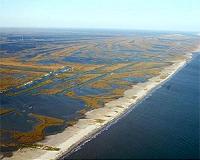 |
New Orleans LA (SPX) May 27, 2011 Researchers have discovered a high concentration of bacteria in the center of hailstones, suggesting that airborne microorganisms may be responsible for that and other weather events. They report their findings at the 111th General Meeting of the American Society for Microbiology in New Orleans. "Bacteria have been found within the embryo, the first part of a hailstone to develop. The embryo is a snapshot of what was involved with the event that initiated growth of the hailstone," says Alexander Michaud of Montana State University in Bozeman, who presented the research. Michaud and his colleagues analyzed hailstones over 5 centimeters in diameter that were collected on the University campus after a storm in June 2010. The large hailstones were seperated into 4 layers and the meltwater from each layer was analyzed. The number of culturable bacteria was found to be highest in the inner cores of the hailstone. "In order for precipitation to occur, a nucleating particle must be present to allow for aggregation of water molecules," says Michaud. "There is growing evidence that these nuclei can be bacteria or other biological particles." Michaud's research is part of a growing field of study focusing on bioprecipitation, a concept where bacteria may initiate rainfall and other forms of precipitation including snow and hail. The formation of ice in clouds, which is necessary for snow and most rainfall events, requires ice nuclei (IN), particles that the ice crystals can grow around. "Aerosols in clouds play key roles in the processes leading to precipitation due to their ability to serve as sites for ice nucleation. At temperatures warmer than -40 degrees Celsius ice formation is not spontaneous and requires an IN," says Brent Christner of Louisiana State University, also presenting at the meeting. A diverse range of particles are capable of serving as IN, but the most active naturally occurring IN are biological in origin, capable of catalyzing ice formations at temperatures near -2 degrees Celsius. The most well-studied biological IN is the plant pathogen Psuedomonas syringae. "Ice nucleating strains of P. syringae possess a gene that encodes a protein in their outer membrane that binds water molecules in an ordered arrangement, providing a very efficient nucleating template that enhances ice crystal formation," says Christner. Aerosol-cloud simulation models imply that high concentrations of biological IN may influence the average concentration and size of ice crystals in clouds, horizontal cloud coverage in the free troposphere, precipitation levels at the ground and even insulation of the earth from solar radiation. "Evidence for the distribution of biological IN in the atmosphere coupled with the warm temperatures at which they function as IN has implied that biological IN may play a role in the Earth's hydrological cycle and radiative balance," says Christner.
Share This Article With Planet Earth
Related Links American Society for Microbiology Water News - Science, Technology and Politics
 LSU Researchers Study Methods to Use River Sediment to Repair the Coast
LSU Researchers Study Methods to Use River Sediment to Repair the CoastBaton Rouge LA (SPX) May 23, 2011 As the already gargantuan body of water swells beyond its normal manmade boundaries, the state of Louisiana is starting to see impact after having seen the damage already done to states from Missouri to Mississippi. While near record-breaking water levels are expected any day now and safety precautions are being taken, one LSU professor explained how the river's meandering historic path and silt ... read more |
|
| The content herein, unless otherwise known to be public domain, are Copyright 1995-2010 - SpaceDaily. AFP and UPI Wire Stories are copyright Agence France-Presse and United Press International. ESA Portal Reports are copyright European Space Agency. All NASA sourced material is public domain. Additional copyrights may apply in whole or part to other bona fide parties. Advertising does not imply endorsement,agreement or approval of any opinions, statements or information provided by SpaceDaily on any Web page published or hosted by SpaceDaily. Privacy Statement |